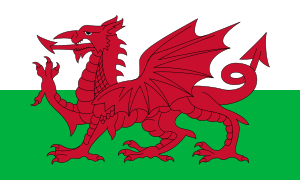Welsh

This book has been written as an aid to learning Welsh (Cymraeg or y Gymraeg, pronounced [kəmˈrɑːɨɡ], [ə ɡəmˈrɑːɨɡ]). It is a Celtic language originating in Wales (Cymru), but is now only spoken by around a quarter of the Welsh population, as English has started to become the norm. It is also spoken in the Welsh settlement in the Chubut Valley of Patagonia, Argentina. There are also speakers of Welsh throughout the world, most notably in the rest of Great Britain, the United States, Canada and Australia. Although coming from Wales, the large majority of the population can speak English. Welsh is spoken more in North Wales, but it is a legal requirement to satisfy both Welsh and English speakers and provide services in both languages throughout Wales. Most people in South Wales cannot speak Welsh, although it is encouraged in schools. The vast majority of children in Wales know some Welsh, and many are educated via the language, even if this is not their mother tongue. If visiting Wales, English will suffice; likewise Spanish is the primary language of Patagonia. Welsh is well worth learning if you require a job in Wales working in public services, or living here.
Due to the increasing use of the English language the numbers of Welsh speakers had been declining for decades. However, following a number of measures, including the introduction of the Welsh Language Act in 1993, Welsh has enjoyed a strong revival in recent years and now officially has an equal status with English in the public sector in Wales. It is now the most widely spoken Celtic language.
| Latin | Irish | Welsh | English |
|---|---|---|---|
| Quis | Cé | Pwy | Who |
| Caput | Ceann | Pen | Head |
An Indo-European language, Welsh belongs to the Brythonic branch of Celtic Languages, which includes Breton and Cornish. This branch is also named "P-Celtic", because the "qu" consonant of Indo-European origin became a "p". In the other branch, including Irish and Scots Gaelic, this consonant kept the same sound, giving rise to the name "Q-Celtic". This is shown on the table to the right:
Introduction to Welsh
The following should be completed before beginning the Welsh course. You will learn how to pronounce Welsh, learn some basic greetings, count to 10, and learn a little bit about the grammar that you will face when learning Welsh.
Lessons
Lessons will eventually cover all levels of Welsh. Mynediad, 'entry' in Welsh, is the first and is suitable for complete beginners to the language.
Mynediad (Entry):
- Lesson 1: 'What's your name?' Introducing yourself
- Lesson 2: 'Where do you work?' Talking about yourself
- Lesson 3: 'No, thank you.' Negating sentences
- Lesson 4: Talking about others
- Lesson 5: 'Where do you come from?' The soft mutation
- Lesson 6: 'Do you have children?' Talking about possession
- Lesson 7: More on numbers and plurals
- Lesson 8: 'Do you have the time?' Time and Weather
- Lesson 9: The Perfect Tense
- Lesson 10: Past tense of 'to go'
- Lesson 11: Checkpoint
- Lesson 12: Past tense of 'to do'
- Lesson 13: Past tense of 'to have'
- Lesson 14: The past tense in full
- Lesson 15: Obligations and Needs
- Lesson 16: The Future Tense
- Lesson 17: Ailments and Conditions
- Lesson 18: Giving instructions and commands
Sylfaen (Foundation):
- Gwers 1: Revision
- Gwers 2: Discussing your background - Imperfect Tense
- Gwers 3: Passive voice
- Gwers 4: Hoffwn
- Gwers 5: Dylwn
- Gwers 6: Comparisons
- Gwers 7: More on comparisons
- Gwers 8: Short Future Tense
- Gwers 9: Baswn
- Gwers 10: Checkpoint
Canolradd (Intermediate):
Uwch (Higher):
Grammar
| Present Tense | Perfect Tense | The Imperfect Tense | Past Tense |
| The Future Tense | The Conditional Tense | Imperative (commands) | Irregular Forms |
External links
- BBC Learn Welsh
- Say Something in Welsh An audio course teaching modern spoken Welsh
- Forum and Audio resources for learning Welsh
- A Welsh Course by Mark Nodine
- Clwb malu cachu, a website for Welsh learners
- Learn Welsh with S4C
- Welsh Government Translation Service dictionary
Contributors
